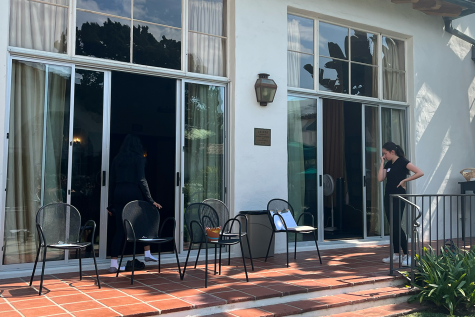Record-setting heat wave challenges community’s first week back
Photo credit: Maia Alvarez
Students gather in the courtyard on the first day of classes to eat lunch and take their yearbook photos while trying to stay in the shade as much as possible. At the start of the new school year, the Los Angeles community experienced California’s hottest and longest heatwave in its history. “It takes a lot of effort for you to do the tasks that you need to do when it’s too hot,” facilities staff member Enrique Montoya said. “You need to keep drinking water and make sure you stay cool throughout the day.”
September 15, 2022
Returning from summer vacation, the Archer community was greeted with more than a warm welcome. Across California, a record-setting heat wave arose, increasing air conditioning usage and threatening electricity outages across the state on Sept. 6. In response to the heat, community members had to make technical and behavioral adjustments.
During the first week of the school year, students took their class photos, walked to their first classes and spent lunch breaks in upper 80 to mid-90-degree weather. Fitness teacher Stephanie Ferri said the fitness department has adjusted to the increasing climate by moving students to the indoor fitness center to prioritize student health.
“In my experience, the first week of school always is the hottest,” Ferri said. “As fitness teachers, it’s in the back of our mind that this week is pretty hot, so we took some initial precautions by setting up tents to provide shade. We realized it was just too hot, so we maneuvered and moved inside for the wellbeing of our students.”
Associate Head of School for Finance and Operations Jane Davis said because the historic building was built in 1932, it is prone to retaining heat and has been slow to fully receive its air conditioners. Davis said students instead can fill their water bottles at the water stations across campus and find shaded areas. Freshman Charlotte Stein said that while drinking plenty of water has helped her overcome the heat, the lack of air conditioning in some classrooms has been difficult.
“Our physics classroom didn’t have [air conditioning] working, and we were in there, so all the marshmallows that we’re using for our project melted,” Stein said. “Then we had to move out of our HD classroom because there was no air conditioning.”
During that past week, facilities staff member Enrique Montoya has worked on resolving the air conditioning problems in the historic building’s classrooms and assembling canopies for students eating lunch or for the fitness classes on the backfield.
“On the newer side of the building, all of the [air conditioning systems] are working properly,” Montoya said. “On the other side, the historical side of the building, we’re implementing that system every year. So now we have an air conditioning unit on the second floor, the language hallway — that whole area has air conditioning.”
Teachers in the Academic Center created a system to donate their classrooms during specific periods of the day to offer working air conditioning systems to teachers in the historic building. In the meantime, Davis said faculty members in the administration hallway haven’t had any air conditioning at all.

“We were supposed to have air conditioning put in this whole admin hallway over the summer, and because of COVID and supply chain, the units weren’t going to be able to be delivered until…the third week of August. So it was too late for us to do it this year,” Davis said. “Everybody went away thinking they were coming back to air conditioning, and they weren’t.”
The Archer campus has many outdoor spaces, including the courtyard and amphitheater, leaving limited shaded spaces to spend breaks. Davis said she worries this will still limit students’ opportunities for connection.
“I feel bad about tomorrow and the first Friday of the year and the courtyard celebration and what that might look like,” Davis said Sept. 8. “[I will] talk to [facilities] about maybe potentially setting up some shade structures out there.”
To combat the heatwave, Governor Gavin Newsom signed new legislation that will create warning systems to protect Californians from heat waves in the future. For now, Davis said temperatures in the coming weeks should drop, but students and faculty should still continue to focus on their wellbeing.
“My advice to people is to stay hydrated, stay out of the sun and try to find some little nooks and crannies in this building where you can sit and have lunch and not be in direct sunlight,” Davis said.
Additional reporting by Lizette Gonzalez, Francie Wallack, and Ella Chang.









